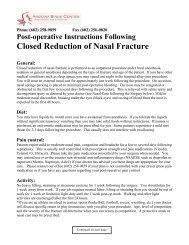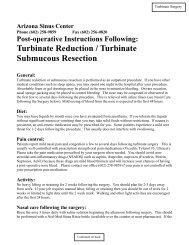Parathyroidectomy Post Operative Instructions - Arizona Sinus Center
Parathyroidectomy Post Operative Instructions - Arizona Sinus Center
Parathyroidectomy Post Operative Instructions - Arizona Sinus Center
You also want an ePaper? Increase the reach of your titles
YUMPU automatically turns print PDFs into web optimized ePapers that Google loves.
<strong>Parathyroidectomy</strong><br />
Phone (602) 258-9859 Fax (602) 256-0820<br />
<strong>Post</strong>-operative <strong>Instructions</strong> following<br />
<strong>Parathyroidectomy</strong><br />
General:<br />
You may be hospitalized for one or two nights following your parathyroid procedure. Your surgeon will<br />
see you each day of your hospitalization to ensure that you are recovering well and confirm that your<br />
post-operative blood calcium level has come into the normal range.<br />
Diet:<br />
You may have liquids by mouth once you have awakened from anesthesia. If you tolerate the liquids<br />
without significant nausea or vomiting then you may take solid foods without restrictions. Generally<br />
patients experience a mild sore throat for 2-3 days following thyroidectomy. This usually does not<br />
interfere with swallowing.<br />
Pain Control:<br />
Patients report mild neck pain for several days following thyroidectomy. This is usually well controlled<br />
with prescription strength oral pain medications (Vicodin, Hydrocodone, Tylenol #3, Ultracet). Please<br />
take the pain medication prescribed by your surgeon when needed. You should avoid non-steroidal antiinflammatory<br />
drugs (NSAIDS) such as aspirin, ibuprofen, naproxen (Excedrin, Motrin, Naprosyn,<br />
Advil) because these drugs are mild blood thinners and will increase your chances of having a postoperative<br />
bleed into the neck tissues or neck wound. Please contact our office (602) 258-9859 if your<br />
pain is not controlled with your prescription pain medication.<br />
Activity:<br />
Sleep with the head elevated for the first 48 hours. You may use two pillows to do this or sleep in a<br />
reclining chair. No heavy lifting or straining for 2 weeks following the surgery. You should plan for 1<br />
week away from work. If your job requires manual labor, lifting or straining then you should be out of<br />
work for 2 weeks or limited to light duty until the 2 week mark.<br />
Wound Care:<br />
The wound closure type dictates the post-operative wound care. The type of wound closure is evident<br />
by looking at your wound. You will either have sutures (black or blue stitches) steri-strips (paper tape<br />
strips) or tissue adhesive (a transparent layer of “skin glue”). If you are not certain which wound closure<br />
type you have please ask your nurse or surgeon. Regardless of the wound closure technique, mild<br />
redness and swelling around the wound is normal and will decrease over the 2 weeks following surgery.<br />
If you have questions about the appearance of the wound you may ask your nurse or surgeon prior to<br />
discharge from the hospital or surgery center. If a drain has been placed in the neck, this will be<br />
removed prior to your discharge unless otherwise directed by your surgeon.<br />
Continued on back
Tissue adhesive wound care instructions:<br />
Do not wash, wet or manipulate the neck wound for 48 hours following surgery. The wound has been<br />
closed with absorbable sutures underneath the skin. There is a protective layer of transparent tissue<br />
adhesive over the wound that seals the skin together during the first week of healing. This provides a<br />
barrier against infection and avoids the nuisance and discomfort of external stitches. This layer of tissue<br />
adhesive will ultimately fall off (slough) in about 7-10 days as your skin is renewed. It is okay to<br />
shower or bathe and get the wound wet 48 hours following surgery. Allow soap and water to run over<br />
the wound. Do not scrub or manipulate the site. You should gently pat the area dry, but don’t rub it<br />
with a towel. Do not apply ointments, lotions or creams to the tissue adhesive over the wound.<br />
Steri-strip wound care instructions:<br />
Do not wash or manipulate the neck wound for 48 hours following surgery. The wound has been closed<br />
with absorbable sutures underneath the skin. There is a layer of paper tape strips (Steri-strips) covering<br />
the incision site. This layer of Steri-strips provides extra support to the wound for the first 7-10 days<br />
following the surgery. It is okay to get these Steri-strips wet after 48 hours from the time of surgery.<br />
Therefore, you may shower and allow the wound and strips to get wet 2 days following the surgery.<br />
Allow soap and water to run over the strips. Do not scrub or manipulate the site. Pat the area dry, but<br />
don’t rub it with a towel. A hair dryer on cool setting may also be used to dry the Steri-strips. The<br />
Steri-strips will start to roll up on the edges and eventually fall off on their own after about 10 days. If<br />
the strips are curling at the edges but not falling off, you may trim them with small, clean cuticle scissors<br />
purchased at your local pharmacy. Once the Steri-strips have all fallen off you may gently lather the site<br />
with soap and water when washing.<br />
Sutures wound care instructions:<br />
Do not wash or manipulate the neck wound for 48 hours following surgery (except to apply ointment).<br />
The neck dressing will be removed on the morning following your surgery. Please take a moment to<br />
look at the wound in the mirror prior to your discharge from the hospital. You will find that the skin has<br />
been closed with sutures that will be removed at your one week follow-up appointment. Once you are<br />
home, apply a thin layer of the prescribed antibiotic ointment to the wound 3 times daily. This is best<br />
accomplished by washing your hands thoroughly with soap and water and then gently coating the wound<br />
with ointment using your finger. If you have a history of eczema, then apply Vaseline petroleum jelly to<br />
the wound 3 times daily instead of the antibiotic ointment. You may shower and allow the wound to get<br />
wet 48 hours following the surgery. Allow soap and water to run over the wound. Do not scrub or<br />
manipulate the wound for 7 days. Pat the area dry, don’t rub it with a towel. After 7 days you may<br />
gently lather the wound with soap and water. Sutures are removed at your first post-operative visit.<br />
Follow-up Appointment:<br />
Your follow-up appointment in the office will be 5-8 days following your surgery. This visit should be<br />
scheduled prior to your surgery (at the time of your pre-operative visit). If you do not have the<br />
appointment made, please contact our office when you arrive home from the hospital. At the postoperative<br />
visit, your surgical site is examined and your pathology report is reviewed with you.<br />
Continued on next page
Please call our office immediately if you experience:<br />
*Difficulty breathing (call 911 first)<br />
*Neck swelling<br />
*Numbness or tingling in your fingertips or lips<br />
*Muscle cramps or spasms<br />
*Bleeding from the wound<br />
*Choking or coughing when drinking liquids<br />
*Fever greater than 101 degrees Fahrenheit<br />
*Purulent discharge (pus) coming from the wound<br />
*Increasing redness around the wound<br />
Office phone: (602) 258-9859<br />
Website: www.arizonasinus.com






